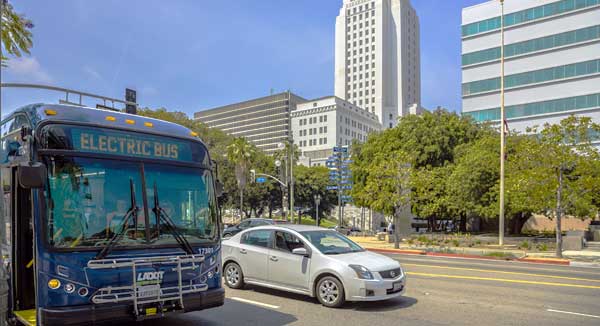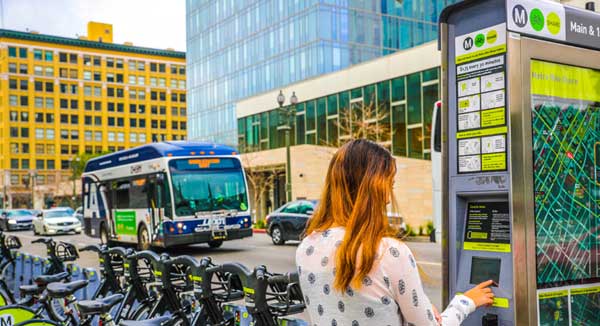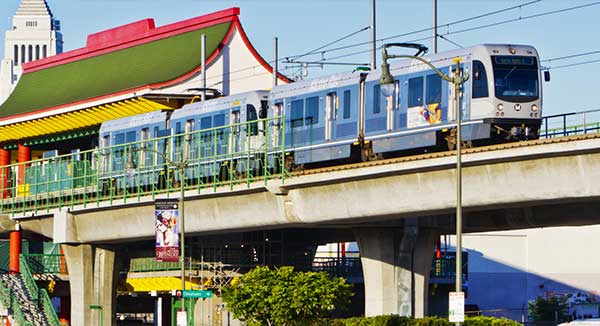Reflecting its commitment to equity and environmental justice, Los Angeles City Planning has established street standards that provide safe and efficient transportation options for pedestrians, bicyclists, transit riders, and motorists. City Planning’s prioritized set of land use and transportation considerations strive toward equity in safety, public health, and access. For additional information, contact Planning.Mobility@lacity.org.
Mobility
A city as diverse as Los Angeles requires a transportation system that accommodates all users.




Mobility Element of the General Plan
The Mobility Plan 2035—one of the Elements of the City’s General Plan—lays out the policy foundation for achieving a transportation system that balances the needs of all road users. The priorities of the Mobility Plan 2035 include:
- Safety First: Focusing on safety, education, and enforcement
- Access for all Angelenos: Increasing access through greater community connections
- World Class Infrastructure: Investing in the construction of Complete Streets Networks
- Collaboration, Communications, and Informed Choices: Using open data and information to inform future policy considerations
- Clean Environment & Healthy Communities: Tackling issues related to the overall health and sustainability of Los Angeles’ neighborhoods
The Complete Streets Design Guide accompanies the Mobility Plan 2035, outlining the vision for designing safe, accessible, and vibrant streets in Los Angeles. The guide compiles design concepts and best practices that promote safe and accessible streets.
The updated Streets Dimension Standard Plan (Standards S-470-1) reflects an expanded suite of street arterials and non-arterials to align with the goals and policies of the Mobility Plan 2035.
Transportation Demand Management (TDM) Program Update
Los Angeles City Planning and Los Angeles Department of Transportation are working to update the City’s Transportation Demand Management (TDM) Program to meet transportation demand in a sustainable way. The proposed update would require certain new development projects to implement strategies such as supporting transit, telecommuting, walking, carshare, neighborhood shuttles, and other strategies that reduce vehicle trips.
Today, more mobility options are available than ever before through an expanding transit system and new services, such as bike share, car share, on-demand transit, real time information, and smart technologies. An update to the City’s original TDM ordinance from 1993 complements the efforts to implement the Mobility Plan 2035 and provide access for all Angelenos, clean environments, and healthy communities. With the goal of reducing drive-alone trips and Vehicle Miles Traveled (VMT), updating the TDM Program is part of a larger State-mandated effort to improve air quality and reduce greenhouse gas emissions by promoting more sustainable transportation options.
The TDM program update has three overarching goals. First, the program seeks to reduce greenhouse gas emissions by reducing the amount of vehicle miles traveled (VMT) generated by automobiles. Second, the program presents an updated and expanded set of TDM strategies, including telecommuting and bike share, to allow developers to take advantage of the latest mobility technologies and use strategies that suit their specific project. Lastly, the program will focus on expanding access to the transportation network through investments in bike and pedestrian infrastructure. The updated TDM program can lead to improved quality of life by making efficient use of the City's mobility network and can improve public health by enabling active transportation choices like biking and walking.
Outreach and Events
Planning staff released initial drafts of the TDM Ordinance and TDM Program Guidelines for public review, held three informational webinars, and hosted office hours in Summer 2021. Following this outreach, staff incorporated public feedback into revised drafts of the TDM Ordinance and Program Guidelines, which were released in July 2022.
On August 2, 2022, City staff held an Open House & Public Hearing. Links to the hearing notice, presentation, and full recording can be found below.
Adoption Process
The City Planning Commission recommended the TDM Ordinance for approval on Thursday, September 22, 2022. The City Council’s Planning and Land Use Management (PLUM) Committee and Transportation Committee recommended the TDM Ordinance for approval with minor amendments on Tuesday, November 1, 2022.
As of January 2023, the TDM Ordinance is being reviewed by the City Attorney and is anticipated to return to the City Council for adoption in Spring 2023 before being signed by the Mayor.
New documents, reports, and decisions of the City Council will be posted to Council File (CF) 15-0719-S19. To view documents in the Council File click here. To sign up to get email updates from the City Clerk throughout the adoption process, click on the envelope icon at the top of the Council File page.
Program Documents
There are three main components of the proposed TDM Program. An Ordinance will update the TDM requirements in the zoning code. A new Program Guidelines document will provide details on the TDM Program strategies and process. An online TDM Calculator tool will provide a simple process for applicants to enter project information, understand the TDM requirements, and select TDM strategies.
Council File
City Planning Commission, September 22, 2022
- Letter of Determination
- Staff Report with attachments (Draft TDM Ordinance, Program Guidelines, etc)
- Notice of Public Hearing
- City Planning Commission Agenda
- City Planning Commission Meeting Audio
Public Hearing Draft, June 2022
- Revised Draft TDM Ordinance (June 2022)
- Revised Draft TDM Program Guidelines (June 2022)
- Draft TDM Calculator (beta version)
Prior Drafts, 2021:
- Draft TDM Ordinance (June 2021 - prior version)
- Draft TDM Program Guidelines (June 2021 - prior version)
Fact Sheet
Open House & Public Hearing (August 2, 2022)
- TDM Open House Presentation
- TDM Open House & Public Hearing full recording
- Notice of Virtual Open House & Public Hearing
Additional Background Information
Great Streets Challenge Grant
The Great Streets Challenge is a program of Los Angeles Mayor Eric Garcetti’s Great Streets Initiative to envision, collaborate on, and build transformative street infrastructure projects. The Department of City Planning collaborates with the Mayor’s Office on the Great Streets Challenge to provide assistance in community outreach and engagement for planning the future of our streets. The Great Streets Challenge aims to:
- Build strong partnerships between communities and the City of Los Angeles
- Empower communities to develop a vision to transform their corridors
- Design streets with a community’s vision of how to improve our neighborhoods for all people
- Implement projects that transform our streets into safe, accessible, and vibrant public spaces in alignment with adopted City policies
Affordable Housing Sustainable Communities (AHSC) Grant Program
The Affordable Housing Sustainable Communities is a competitive State grant program that funds projects that provide affordable housing in conjunction with transportation-related infrastructure such as bike, transit, and pedestrian amenities. The program aims to reduce greenhouse gas emissions (GHGs) and Vehicle Miles Traveled (VMT) by promoting infill development and connecting housing to jobs, services, and destinations via transit and other sustainable travel modes. Along with the Los Angeles Department of Transportation (LADOT) and the Los Angeles Housing and Community Investment Department (HCIDLA), LACP partners with Los Angeles developers to deliver projects that can successfully compete for funding across the State. For information on the program and how to apply, visit the HCID website.
Transportation Analysis Update
City Planning, in collaboration with LADOT, worked to update the City of Los Angeles's approach to transportation analysis.
This effort included updating the City’s California Environmental Quality Act (CEQA) Guidelines to comply with and implement recent changes to State law. Senate Bill 743 required all California cities to update the way they measure transportation-related impacts to Vehicle Miles Traveled (VMT) prior to July 1, 2020. This approach can reduce transportation-related greenhouse gas emissions, prioritize the safety, comfort, and access of all street users, and plan for well-connected, healthy communities. LA City Planning and LADOT implemented the shift to VMT in July 2019, a year in advance of the state’s deadline. LADOT updated the Transportation Assessment Guidelines for development projects shortly thereafter.
For more information and links to relevant documents, forms, and tools, visit the LADOT Development Review website.
Informational Video: Vehicle Miles Traveled
- Los Angeles Readies to Adopt VMT for CEQA Analysis │ UrbanizeLA Article
Mobility Plan Progress Reports
The City produces a periodic report on its status in implementing the Mobility Element’s Action Programs, as called for in the Mobility Plan 2035.
